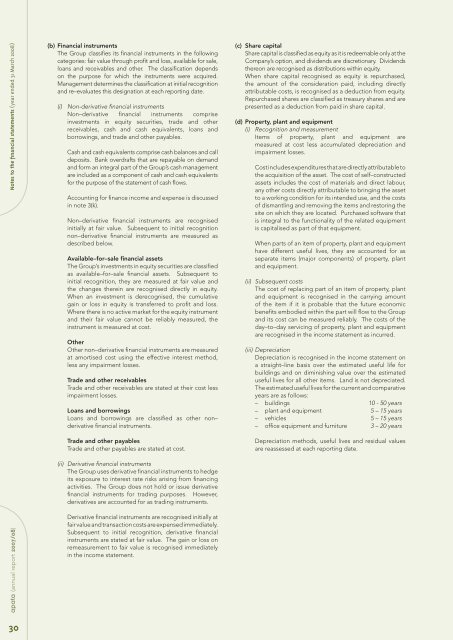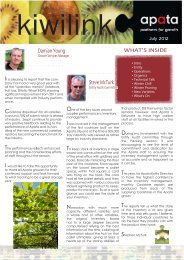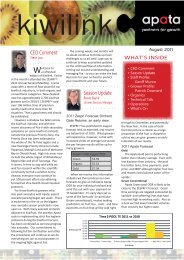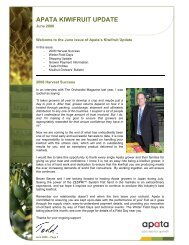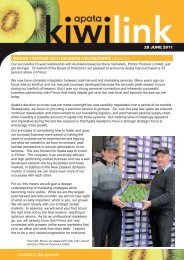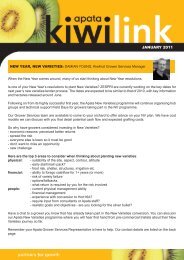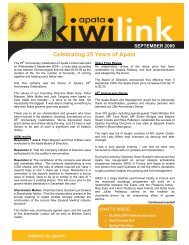Apata Limited and Group
Apata Limited and Group
Apata Limited and Group
Create successful ePaper yourself
Turn your PDF publications into a flip-book with our unique Google optimized e-Paper software.
Notes to the financial statements (year ended 31 March 2008)<br />
apata (annual report 2007/08)<br />
30<br />
(b) Financial instruments<br />
The <strong>Group</strong> classifies its financial instruments in the following<br />
categories: fair value through profit <strong>and</strong> loss, available for sale,<br />
loans <strong>and</strong> receivables <strong>and</strong> other. The classification depends<br />
on the purpose for which the instruments were acquired.<br />
Management determines the classification at initial recognition<br />
<strong>and</strong> re–evaluates this designation at each reporting date.<br />
(i) Non-derivative financial instruments<br />
Non–derivative financial instruments comprise<br />
investments in equity securities, trade <strong>and</strong> other<br />
receivables, cash <strong>and</strong> cash equivalents, loans <strong>and</strong><br />
borrowings, <strong>and</strong> trade <strong>and</strong> other payables.<br />
Cash <strong>and</strong> cash equivalents comprise cash balances <strong>and</strong> call<br />
deposits. Bank overdrafts that are repayable on dem<strong>and</strong><br />
<strong>and</strong> form an integral part of the <strong>Group</strong>’s cash management<br />
are included as a component of cash <strong>and</strong> cash equivalents<br />
for the purpose of the statement of cash flows.<br />
Accounting for finance income <strong>and</strong> expense is discussed<br />
in note 3(k).<br />
Non–derivative financial instruments are recognised<br />
initially at fair value. Subsequent to initial recognition<br />
non–derivative financial instruments are measured as<br />
described below.<br />
Available–for–sale financial assets<br />
The <strong>Group</strong>’s investments in equity securities are classified<br />
as available–for–sale financial assets. Subsequent to<br />
initial recognition, they are measured at fair value <strong>and</strong><br />
the changes therein are recognised directly in equity.<br />
When an investment is derecognised, the cumulative<br />
gain or loss in equity is transferred to profit <strong>and</strong> loss.<br />
Where there is no active market for the equity instrument<br />
<strong>and</strong> their fair value cannot be reliably measured, the<br />
instrument is measured at cost.<br />
Other<br />
Other non–derivative financial instruments are measured<br />
at amortised cost using the effective interest method,<br />
less any impairment losses.<br />
Trade <strong>and</strong> other receivables<br />
Trade <strong>and</strong> other receivables are stated at their cost less<br />
impairment losses.<br />
Loans <strong>and</strong> borrowings<br />
Loans <strong>and</strong> borrowings are classified as other non–<br />
derivative financial instruments.<br />
Trade <strong>and</strong> other payables<br />
Trade <strong>and</strong> other payables are stated at cost.<br />
(ii) Derivative financial instruments<br />
The <strong>Group</strong> uses derivative financial instruments to hedge<br />
its exposure to interest rate risks arising from financing<br />
activities. The <strong>Group</strong> does not hold or issue derivative<br />
financial instruments for trading purposes. However,<br />
derivatives are accounted for as trading instruments.<br />
Derivative financial instruments are recognised initially at<br />
fair value <strong>and</strong> transaction costs are expensed immediately.<br />
Subsequent to initial recognition, derivative financial<br />
instruments are stated at fair value. The gain or loss on<br />
remeasurement to fair value is recognised immediately<br />
in the income statement.<br />
(c) Share capital<br />
Share capital is classified as equity as it is redeemable only at the<br />
Company’s option, <strong>and</strong> dividends are discretionary. Dividends<br />
thereon are recognised as distributions within equity.<br />
When share capital recognised as equity is repurchased,<br />
the amount of the consideration paid, including directly<br />
attributable costs, is recognised as a deduction from equity.<br />
Repurchased shares are classified as treasury shares <strong>and</strong> are<br />
presented as a deduction from paid in share capital.<br />
(d) Property, plant <strong>and</strong> equipment<br />
(i) Recognition <strong>and</strong> measurement<br />
Items of property, plant <strong>and</strong> equipment are<br />
measured at cost less accumulated depreciation <strong>and</strong><br />
impairment losses.<br />
Cost includes expenditures that are directly attributable to<br />
the acquisition of the asset. The cost of self–constructed<br />
assets includes the cost of materials <strong>and</strong> direct labour,<br />
any other costs directly attributable to bringing the asset<br />
to a working condition for its intended use, <strong>and</strong> the costs<br />
of dismantling <strong>and</strong> removing the items <strong>and</strong> restoring the<br />
site on which they are located. Purchased software that<br />
is integral to the functionality of the related equipment<br />
is capitalised as part of that equipment.<br />
When parts of an item of property, plant <strong>and</strong> equipment<br />
have different useful lives, they are accounted for as<br />
separate items (major components) of property, plant<br />
<strong>and</strong> equipment.<br />
(ii) Subsequent costs<br />
The cost of replacing part of an item of property, plant<br />
<strong>and</strong> equipment is recognised in the carrying amount<br />
of the item if it is probable that the future economic<br />
benefits embodied within the part will flow to the <strong>Group</strong><br />
<strong>and</strong> its cost can be measured reliably. The costs of the<br />
day–to–day servicing of property, plant <strong>and</strong> equipment<br />
are recognised in the income statement as incurred.<br />
(iii) Depreciation<br />
Depreciation is recognised in the income statement on<br />
a straight–line basis over the estimated useful life for<br />
buildings <strong>and</strong> on diminishing value over the estimated<br />
useful lives for all other items. L<strong>and</strong> is not depreciated.<br />
The estimated useful lives for the current <strong>and</strong> comparative<br />
years are as follows:<br />
– buildings 10 - 50 years<br />
– plant <strong>and</strong> equipment 5 – 15 years<br />
– vehicles 5 – 15 years<br />
– office equipment <strong>and</strong> furniture 3 – 20 years<br />
Depreciation methods, useful lives <strong>and</strong> residual values<br />
are reassessed at each reporting date.


